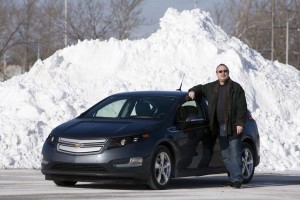(This story has been revised from the original. A full update will be posted on TheDetroitBureau.com later today.)
As it nears the public launch of the much-anticipated Chevrolet Volt, General Motors has decided to add four more states to the initial three where the plug-in hybrid will first be made available.
Buyers in the greater metro New York area, including New York, New Jersey and Connecticut, as well as those in Texas, will now get first crack at the Chevy Volt when it first rolls off the line, this coming November. GM had originally planned to limit initial availability to three markets: California, M
Meanwhile, GM is planning a nearly 1800-mile “Freedom Drive,” from Austin to New York City, to promote the Chevy Volt debut.
In contrast to a traditional automotive roll-out, the rest of the U.S. and Canada will still have to wait for Volt distribution to slowly expand as production increases and the maker gets the necessary infrastructure in place. Though original plans had called for Volt to be offered across the continent by the end of 2011, GM officials last month confirmed the full launch will likely stretch on into 2012.
(Click Here for that full story.)
The slow roll-out plan is no surprise to industry observers who caution that GM is entering an entirely new world with the introduction of Volt – which the automaker prefers to call an Extended-Range Electric Vehicle, or E-REV, rather than a plug-in hybrid. That reflects the fact that Volt’s wheels will always be driven by its electric motors. The sedan is designed to yield about 40 miles range per charge of its lithium-ion batteries. Then, for longer trips, a small gas engine fires up. But it serves as a generator only, with no transmission connecting it directly to the Volt driveline.
To make good use of the E-REV, a motorist should install a quicker 220-volt charging system, and GM is trying to work with local utilities to make that process go smoothly. It also needs to ensure local dealers are properly trained to both sell and service the new technology.
The original three markets also present political opportunities, as GM has and will continue to use Volt as the sheet metal face of its efforts to go green.
While the Big Apple itself poses some technical challenges — particularly in lining up chargers in a city where a sizable number of residents have no garage, or use public parking facilities – it remains the national media hub. And the greater New York area, from the tony suburbs of Connecticut to the beaches of New Jersey, remain a major automotive market where long commutes are a way of daily life.
Texas may be home to the oil industry, but there are pockets, meanwhile, of strong interest in things green. Austin, in particular, has emerged as one of the most battery-car-friendly cities in the country, and one where makers are experimenting with a variety of other transportation options. Daimler AG, for example, recently launched its car2go service in the Texas capital, allowing subscribers to pick up a Smart fortwo at a variety of locations around the city for a quick errand or longer run.
With production getting underway this summer, Chevy hopes to have about 8,000 Volts ready for sale by year’s end. The maker has yet to set a final price, though it has openly hinted at a figure in the range of $40,000. A federal tax credit of $7,500 will be available to buyers – who may also be able to get additional local and state tax breaks, as well as subsidies for charger installation.
(Click Here for more on how thousands of Volt buyers will get free 220-volt chargers.)
So far, GM has invested about $500 million into the Volt program, however some of that will go towards additional E-REV programs. The maker plans to launch a European variant, the Opel Ampera, which is based on the same battery technology, and which will go into production in 2011. Future E-REVs are reportedly under development, though the GM Board of Directors recently vetoed a Cadillac version of the Volt, previewed as the Caddy Converj concept vehicle.

